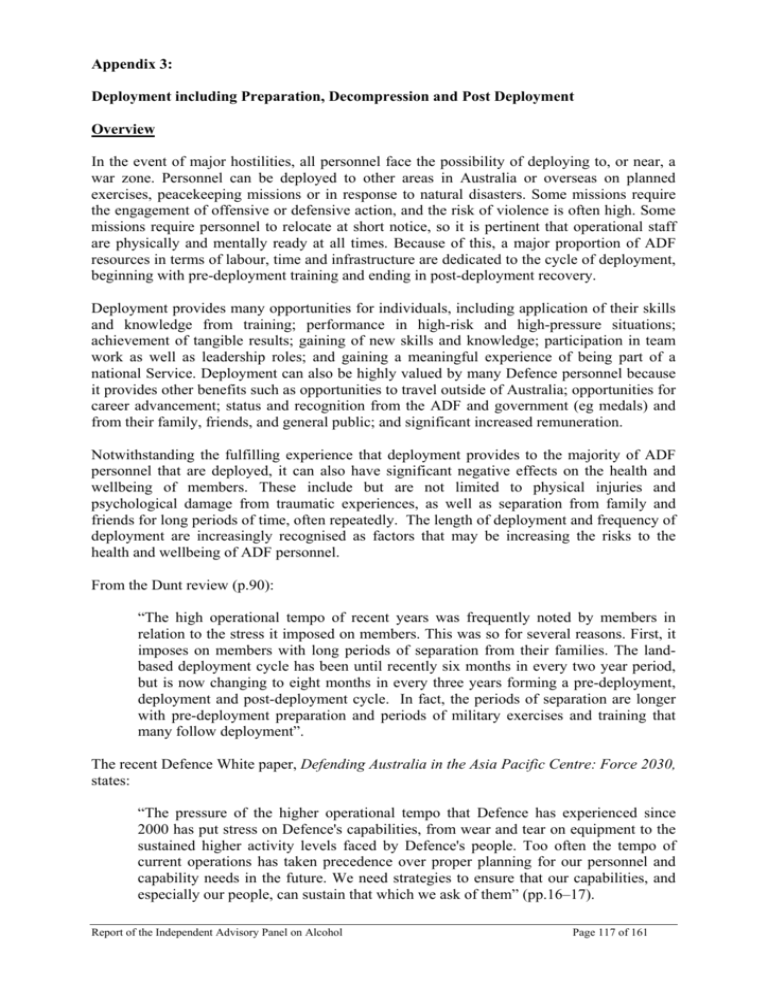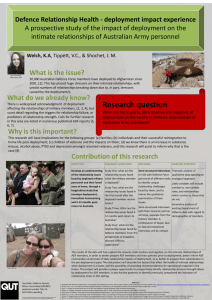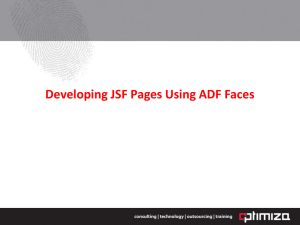Appendix 3: Deployment including Preparation, Decompression and
advertisement

Appendix 3: Deployment including Preparation, Decompression and Post Deployment Overview In the event of major hostilities, all personnel face the possibility of deploying to, or near, a war zone. Personnel can be deployed to other areas in Australia or overseas on planned exercises, peacekeeping missions or in response to natural disasters. Some missions require the engagement of offensive or defensive action, and the risk of violence is often high. Some missions require personnel to relocate at short notice, so it is pertinent that operational staff are physically and mentally ready at all times. Because of this, a major proportion of ADF resources in terms of labour, time and infrastructure are dedicated to the cycle of deployment, beginning with pre-deployment training and ending in post-deployment recovery. Deployment provides many opportunities for individuals, including application of their skills and knowledge from training; performance in high-risk and high-pressure situations; achievement of tangible results; gaining of new skills and knowledge; participation in team work as well as leadership roles; and gaining a meaningful experience of being part of a national Service. Deployment can also be highly valued by many Defence personnel because it provides other benefits such as opportunities to travel outside of Australia; opportunities for career advancement; status and recognition from the ADF and government (eg medals) and from their family, friends, and general public; and significant increased remuneration. Notwithstanding the fulfilling experience that deployment provides to the majority of ADF personnel that are deployed, it can also have significant negative effects on the health and wellbeing of members. These include but are not limited to physical injuries and psychological damage from traumatic experiences, as well as separation from family and friends for long periods of time, often repeatedly. The length of deployment and frequency of deployment are increasingly recognised as factors that may be increasing the risks to the health and wellbeing of ADF personnel. From the Dunt review (p.90): “The high operational tempo of recent years was frequently noted by members in relation to the stress it imposed on members. This was so for several reasons. First, it imposes on members with long periods of separation from their families. The landbased deployment cycle has been until recently six months in every two year period, but is now changing to eight months in every three years forming a pre-deployment, deployment and post-deployment cycle. In fact, the periods of separation are longer with pre-deployment preparation and periods of military exercises and training that many follow deployment”. The recent Defence White paper, Defending Australia in the Asia Pacific Centre: Force 2030, states: “The pressure of the higher operational tempo that Defence has experienced since 2000 has put stress on Defence's capabilities, from wear and tear on equipment to the sustained higher activity levels faced by Defence's people. Too often the tempo of current operations has taken precedence over proper planning for our personnel and capability needs in the future. We need strategies to ensure that our capabilities, and especially our people, can sustain that which we ask of them” (pp.16–17). Report of the Independent Advisory Panel on Alcohol Page 117 of 161 Given the high necessity for operational readiness and the well publicised negative consequences of deployment and the link with excessive alcohol consumption, the deployment cycle has been a priority for the Panel. Whilst alcohol consumption by members on deployment is not permitted, or at least in very limited amounts in exceptional situations, it is suggested that some level of risky consumption still sometimes occurs. Alcohol consumption during deployment poses particular risks to the ADF because it can undermine capability, and in particular, can threaten the health and safety of personnel. Alcohol-related incidents on deployment can also cause significant reputational and potential diplomatic damage to the ADF and threaten the safety of the member(s) involved, especially when they occur in an overseas location. Risky alcohol use is more likely to occur following deployment, sometimes as part of group social activities upon returning to Australia, or as part of an individual’s response to the pressures, stressors and traumatic experiences of their recent deployment experience. Decompression A decompression period immediately following a deployment operation is standard practice in many armed forces, where combat troops are given a short period of leave and psychological support following deployment. However, it is well known that alcohol continues to play a significant role in this process (Fossey 2010). The Australian Defence Force is in the process of trialling Third Location Decompression (TLD), thus the impact on alcohol consumption is unclear at this stage. It has, however, been part of the US military end-of-deployment policies since the Vietnam War and it is viewed as a stress management exercise to transition personnel back into their home life and ensure they are prepared for their next deployment. In Canada and the UK third location decompression (or normalisation as it is referred to in the UK) is an optional exercise at the end of deployment activities, and aims to reintroduce personnel to drinking in a responsible manner (ADF 2011). Minimal evaluation of the impact of TLD on alcohol consumption has been undertaken. However, a study by Hacker-Hughes et al (2008) reported that personnel who spent one week or less in decompression were 1.13 times more likely to drink heavily than those that went straight home; those that spent one to two weeks in decompression were 1.2 times more likely to drink heavily; and those that spent more than two weeks in decompression were 1.17 times more likely to consume heavily. Thus, personnel involved in decompression were more likely to drink heavily compared to those that returned home immediately following deployment. A briefing from the ADF Joint Health Command (5 April 2011) reported some satisfaction data from the UK and Canada. In the UK study on decompression in Cyprus, it was found that approximately 80% of personnel did not want to participate in TLD or were ambivalent about participation prior to their arrival. However, the majority (91%) reported having found TLD useful upon completion and 80% of TLD activities were seen as being generally helpful. About 70% of decompressing troops thought that the briefings would be helpful in easing their transition home and the three groups of personnel least likely to perceive TLD as being helpful were NCOs/SNCOs, troops serving in the Combat Arms and those who reported low levels of adjustment concerns. Report of the Independent Advisory Panel on Alcohol Page 118 of 161 The UK decompression program currently limits personnel to five cans of beer per person, per day, after Day 1 (ACDMH 2009). Anecdotally, there is evidence that following controlled drinking during decompression, there was a drop in alcohol-fuelled assaults/injuries on return to the UK, though it was stated that there were incidents during decompression. A study of the program found that 5.1% of respondents commented on alcohol consumption: 44% of these responses were requests for greater alcohol availability both in quantity and choice, and 22% were requests for less alcohol. In the Canadian study on decompression (also in Cyprus), it was reported that the majority of respondents (96%) reported that they “Agree” or “Strongly Agree” that some form of TLD was a good idea; 86% of respondents reported that they “Agree” or “Strongly Agree” that the TLD experience was valuable; and 90% of respondents recommended it for future rotations to Afghanistan. At 6 months post-decompression, 86% agreed that TLD was valuable and 83% felt that the program made the reintegration process easier for them. In addition, in an evaluation of a Canadian decompression program in Guam, it was reported that many participants reported appreciation of the extra effort and expense which the Canadian Forces invested in order to ensure that they were properly cared for and followed-up. Many participants commented about the need for downtime, and how much they had enjoyed the chance just to have a beer and unwind in a North American type of atmosphere. Their spouses also noted the positive effect a few days of down time before the troops got home had on their readiness to rejoin their families, and many participants had positive comments about the lectures that were provided during the TLD. The Canadian Forces reported a small number of alcohol-related medical problems during the early stages of TLD (seven trauma incidents, mostly involving fights, and three cases of alcohol poisoning). Recurring events were successfully remedied by introducing a number of counter measures, including an orientation brief and a buffet lunch. Review of ADF data regarding alcohol consumption and harm The data review identified two potential datasets for describing alcohol consumption and harm during the deployment cycle, however, all of them focussed on the deployment and post-deployment stage rather than the pre-deployment or decompression. 1. Post-Operational Psychological Screen (POPS) It is mandatory that all personnel complete a POPS in the three to six months following return to Australia from deployment. The screen consists of basic demographic information including age, service, rank and deployment information; the AUDIT; the K10 (depression) and the PCL-C (Post-Traumatic Stress Disorder). Whilst the survey is self-administered, it is reviewed during an interview with a mental health professional. The survey and interview allows for the clinical diagnosis of alcohol-related problems. As such the POPS data provide comprehensive information on alcohol consumption amongst post-deployed personnel. As approximately 7,000 of 50,000 personnel are deployed each year (13%), the POPS data are not representative of all ADF personnel. Nonetheless, POPS data were requested for the 2007 to 2010 period regarding AUDIT and demographic data. Report of the Independent Advisory Panel on Alcohol Page 119 of 161 2. ADF Policing and Securities Management System It is mandatory for all ADF personnel to report any convictions, that is, any incidents that resulted in legislative or disciplinary action within the ADF or the civil jurisdictions). This reporting system records information on all convictions. It provides information on the total number of convictions and the number recorded as alcohol-related for each service. It should be noted that alcohol involvement is somewhat subjective based on the details of the incident. This dataset captures alcohol-related harm data that is not captured by any other datasets (with the exception of AIMS), and can report on alcohol-involved convictions whilst on deployment. However, there is potential for under-reporting due to the self-reported nature of the conviction. Also, whilst personal and conviction characteristic data are included in the system, it is currently not in format that allows for easy extraction of such information. For example, the system is unable to easily extract information on offence categories (eg assaults, offensive conduct) and certain sub-populations (eg younger personnel, rank, gender). 3. Research study into the adjustment and reintegration experience of Australian Army Reserve Personnel following full-time service This study is an independent study aimed at evaluating whether the participation of Army Reservists in fulltime military activity including a deployment overseas on operations will lead to longer adjustment and re-integration for Reservists than their Regular Army counterparts9. This study involved the development of an ADF Members Questionnaire that focussed on mental health and alcohol consumption. Two groups were followed over time: • Group A (Timor L’Este): Reservists deployed for seven months in war-like service. • Group B (Timor L’Este): Regular personnel deployed for 7 months in war-like service (same deployment and battalion was Group A). All participants completed a mental health survey at a number of intervals, including mandatory ADF screens (RtAPS and POPS). Group A (Reservists) • Time 1: • Time 2: • • • • • RtAPS: Time 3: POPS: Time 4: Time 5: Group B (Regular Army) • RtAPS: • POPS: • Time 5: Concentration weekend pre-deployment End of deployment concurrent with RtAPS (Return to Australia Psychological Screen) Capture of RtAPS data from ADF Six months post deployment (mail-out) Capture of POPS data from ADF One year post deployment (mail-out) Two year post deployment (mail-out) Capture of RtAPS data from ADF Capture of POPS data from ADF Two year post deployment (mail-out) 9 Orme, G ( Unpublished thesis Title: to be inserted when available) Report of the Independent Advisory Panel on Alcohol Page 120 of 161 The screening instruments included a number of mental health measures (eg Kessler 10, PostTraumatic Stress [PCL-C], the Depression, Anxiety and Stress Scale [DASS21]). The Alcohol AUDIT was included at all intervals, with the exception of the RtAPS. Prevalence of alcohol consumption and harm 1. Post-Operational Psychological Screen (POPS) POPS were completed on over 18,000 post-deployment personnel in the years 2007 to 2010 • Hazardous or harmful consumption (AUDIT >=8) o 18.1% of personnel were found to be consuming alcohol at risky or high-risk levels • Alcohol Consumption Score (Total score of questions 1 to 3 >=6) o 31.3% were consuming alcohol at risky levels • Dependency Score (Total score of questions 4 to 6 >=4-12) o 0.8% were possibly dependent • Alcohol-Related Problems Score (Total score of questions 7 to 10 >=1-16) o 22.5% were at-risk of alcohol-related problems The main characteristics associated with hazardous or harmful consumption (AUDIT >=8) were: being male (19.2% compared to 7.8% for females); being aged less than 25 years (26.9% compared to 18.1% for the 25-34 year age group); being a member of the Australian Regular Army (23.6% compared to 7.4% for the Air Force); being deployed on Operation Herrick (23.6%) or Operation Astute (23.2%)(compared to 13.6% for Operation Anode); being deployed for a period of greater than 8 months (34% compared to 14% for those that were deployed for less than 4 months); suffering from very high levels of distress (44.4% compared to 14.8% for low levels); and suffering from high levels of PTSD (51.4% compared to 16.3% for low levels). Research by Saunders and Lee (2000) reported that, in developed countries, the proportion of the population reporting dependency using the AUDIT is typically under 5%; hazardous or harmful drinking is 5 to 15%; and low-risk drinking is 50 to 75%. 2. ADF Policing and Security Management System Preliminary analysis of the dataset indicates that 28.4% of deployment convictions in 2008 were alcohol-related. This compared to 38.5% in 2009 and 31.6% in 2010. 3. Research study into the adjustment and reintegration experience of Australian Army Reserve Personnel following full-time service This study reported that the proportion of reservists (Group A) reporting hazardous/harmful alcohol consumption (AUDIT >=8) was: • 7.5% at Time 1 (pre-deployment screening) • 41.9% at Time 2 (post-deployment survey) • 22.5% at Time 3 (6 mths post-deployment survey) • 29.2% at POPS • 40.4% at Time 4 (12 mths post-deployment survey) • 29.4% at Time 5 (2 year post-deployment survey) Report of the Independent Advisory Panel on Alcohol Page 121 of 161 In comparison, the proportion of regular personnel (Group B*) reporting hazardous/harmful alcohol consumption (AUDIT >=8) was: • 62% at POPS • 50% at Time 5 (2 year post-deployment survey) The study also showed that, at the POPS, 30% of the reservists were consuming at hazardous/harmful levels (AUDIT>=8) compared with just over 60% for the regular personnel. Thus, the regular personnel were consuming at substantially higher rates compared with the reservists at these two occasions. * To be interpreted with caution due to small sample size (13% response rate for Time 5 N=14 compared to 66% for POPS N=72). Conclusion of data analysis Notwithstanding differences in the age and gender characteristics of POPS participants and community level data, the POPS reported prevalence of post-deployment alcohol-related as measured by the AUDIT appears broadly consistent with, or below that reported in community studies. There is a suggestion that this prevalence may be reducing. Whilst the POPS dataset provides valuable information regarding the alcohol consumption and harm status of post-deployed ADF personnel, there are a number of limitations regarding interpretation of such data including: • Double counting of individual personnel due to multiple deployments. • Possible respondent fatigue/response bias/habituation due to multiple surveying after multiple deployments. • Disincentive to report alcohol problems due to perceived risk to career progress, future deployments, etc. Interpretation of the ADF Policing and Security Management System data is also subject to a number of caveats: • Potential for under-reporting due to the self-reported nature of the conviction. • The system is not currently in a format that allows for the easy extraction of specific crime categories (eg assaults) or personnel characteristics (eg age, gender, and rank). 1. Analysis of POPS and other data sets The preliminary analyses of available datasets suggests that further more detailed analyses are required to ensure accurate interpretation of POPS and other data with respect to comparison with other studies, and suggested changes in the prevalence of alcohol related harm. It is recommended that the conduct of such analyses be referred to the current ADFAMS project for consideration. 2. Collection of alcohol consumption data during the pre and post-deployment stages Defence personnel were required to undertake the Comprehensive Preventive Health Examination (PHE) every five years. The PHE includes the AUDIT tool. It is understood that this will replace the AHA that was mandatory for all ADF personnel to complete on an annual basis. The AHA did not include the AUDIT or any other valid measure of alcohol-related harm. Completion rates of these assessments are low. Report of the Independent Advisory Panel on Alcohol Page 122 of 161 The Panel notes that the Australian National Audit Office (2010) recommends that consideration be given to adopting a risk-based approach in preference to annual individual readiness medical checks for all personnel. If this is to occur, it will be important to have broad risk definitions/categories for possible alcohol risk given that the risks and costs of high-risk alcohol use go beyond consideration of individual member’s health. This Panel’s advice is that the AHA (PHE or equivalent) be applied to all deployed personnel 12 months post deployment, and include the full AUDIT. It is recommended that all such surveys be completed by ADF personnel, followed by an interview with a mental health professional (if required) to allow for adequate support and referral. 3. Entry and storage of data in a central repository The proposed JeDHI System has the capacity for health staff to enter the responses of the screening surveys and assessments directly into the system. This will allow for the storage of data in a central repository for effective management and surveillance of alcohol issues. 4. Review of current ADF policies relating to all stages of deployment and alcohol consumption A briefing provided by the ADF Joint Health Command dated 3 February 2011 states that “ADF members deployed on operations do not have regular access to alcohol, although limited access (usually two standard drinks per person) may be permitted on special days (eg ANZAC Day or Christmas) where authorised by the Commanding Officer (CO). Members' access to alcohol during Relief out of Country Leave (ROCL) is not monitored by the ADF. In a planned trial of decompression, ADF members will be reintroduced to alcohol, in limited quantities, in a controlled setting. Policy regarding access to alcohol by deployed Special Forces (SF) is very similar to other ADF members whilst on deployment (eg could be authorised for special occasions at the discretion of the CO)”. In comparison, the U.S. Department of Defence policy is similar to that of the ADF’s, whilst the UK does not allow alcohol to be consumed on deployment. Alcohol is re-introduced to personnel during the decompression period. Similarly, the New Zealand Defence Force does not allow consumption on deployment, although some ‘specialised’ groups have unlimited access. In contrast, the Canada Force policies vary depending on the deployment/location and are set by the chain of command. For example, no alcohol is permitted in Kandahar, whilst personnel located in Kabul and on ‘quieter peacekeeping missions’ are allowed a limit of two drinks per day. 5. Review of the Medical Employment Classification System10 The tri-service MEC (Medical Employment Classification) system is used to inform the employability, deployability and rehabilitation of the member. Because deployment offers personnel with a range of career and material opportunities, maintaining one’s status as “medically fit for employment in a deployed or seagoing environment without restriction” (ie MEC 1) is a continuing priority for many in the ADF. However, while on the one hand the MEC system encourages ADF personnel to maintain good health and wellbeing, it also potentially: Please note in Addendum. 10 Report of the Independent Advisory Panel on Alcohol Page 123 of 161 “encourages members to conceal their mental, and for that matter, physical health problems. These members run the risk of their health breaking down or necessary treatment not being able to be accessed while on deployment. This may require medical extraction imposing a considerable cost burden on the ADF” (p.108, Dent Review). In its recent review of the MEC system the ADF have developed a periodic health examination (PHE) process as a means to assess health issues pertinent to employment and deployment, including medical conditions, occupational exposures, and/or clinical risk factors that may impact on a member’s fitness and safety in a given working environment. The Panel acknowledges and support the inclusion of the AUDIT alcohol screening tool as part of the PHE. Report of the Independent Advisory Panel on Alcohol Page 124 of 161






